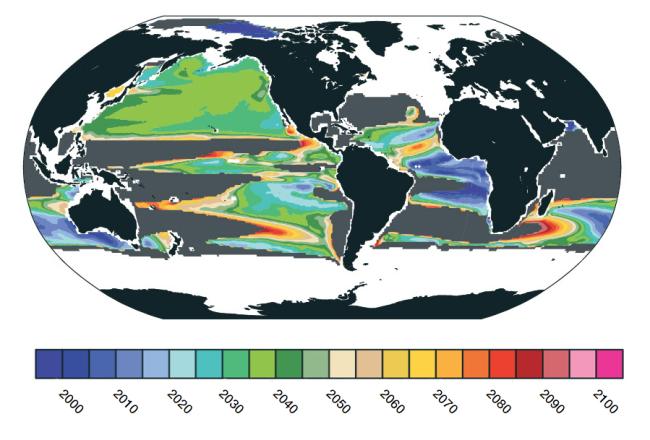Detecting human influence on oceanic oxygen
Dissolved oxygen is critical for marine life and plays an important role mediating biogeochemical cycles. Climate warming drives ocean deoxygenation by warming surface waters, thereby reducing oxygen solubility, but also--and more importantly--warming inhibits surface-to-depth exchange through buoyancy stratification, thus curtailing the supply of oxygen to the ocean interior. There is very little doubt that human-driven climate warming will ultimately result in widespread ocean deoxygenation; however, substantial natural variation in dissolved oxygen concentrations and sparse observational records make it difficult to determine when this impact is evident. The basic problem is that long-timescale fluctuations in ocean oxygen concentrations occur naturally, but observations are insufficient to fully characterize the probability distribution of natural trends--so even indications of long-term oxygen decline can be difficult to definitively attribute to climate change.

Long et al. use a large ensemble of the Community Earth System Model (CESM) to address this detection problem. The large ensemble enables precise separation of natural and forced variability, thus permitting quantification of the point in time when human-influence on oceanic oxygen emerges from the background noise. The model suggests that human-driven changes are evident in many oceanic regions now and will be widespread in the next 15-20 years (see figure). In many cases, however, the model suggests that detection requires better observational records than actually exist. There is substantial spatial variability in the intensity of deoxygenation. The North Pacific, for instance, is strongly impacted, whereas there are regions in the tropics with little change or even slight increases.
A sustained and widespread observing capability could enable prediction of natural fluctuations in oceanic dissolved oxygen and help manage impacts on the natural system. Reversing the deoxygenation trend, however, ultimately requires mitigation of human-driven climate warming.
Finding forced trends in oceanic oxygen (Global Biogeochemical Cycles)
1National Center for Atmospheric Research
2University of Washington
3Georgia Institute of Technology
Topics
- Modeling
- Climate Change
